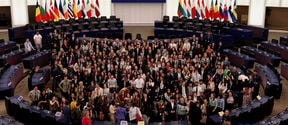Aalto University students designed a fictional city in Paimio

Thirteen students from Aalto University’s urban planning programme brought their innovative visions to life as they created a new, fictional city during a four-day workshop at Paimio Sanatorium. From October 5-8, the students participated in the Incomplete City project, a globally recognized architectural exercise where participants design a city through collaborative drawing. This marks the first Finnish edition of the program, known for its creative and playful approach to urban design.
Originally devised by Marco Ferrari, Joseph Grima and Dan Hill at the UCL Bartlett School of Architecture in 2016, Incomplete City has subsequently run all over the world, eventually becoming a regular fixture of design curricula at architecture schools from Michigan to Melbourne.
“We usually conduct Incomplete City studios in highly urban locations, so to do this one at Paimio Sanatorium is particularly intriguing,” says Dan Hill, Director at the Melbourne School of Design, who guided the students through the exercise. “Our students are working on new visions for Helsinki neighbourhoods, so we expect the collective drawing to be Helsinki-ish but also Paimio-ish, somehow. A bit of the forest in the city, or vice versa, perhaps finding something new.”

Reimagining urban spaces through collaborative design
The students worked in teams, starting by constructing a "Library of Urban Elements." These elements, ranging from benches and trees to more complex urban infrastructure, were then integrated into a larger cityscape to explore broader urban relationships, such as infrastructure, diversity and collaboration.
The workshop is part of a larger course, during which the students collaborate with the City of Helsinki to reinvigorate eight locations in the city centre.
"We are honoured to work with Paimio Sanatorium Foundation and the energetic curators it has selected, in order to dig deeper into the creative evolution of cities,” says Antti Ahlava, Professor of Emergent Design Methodologies at Aalto University.
The workshop also served as an opportunity for students to practice the kind of intense collaboration required for successful urban planning, encouraging them to explore new ways of thinking.

Developing Paimio into a platform for learning and innovation
The workshop culminates in an exhibition as part of the Spirit of Paimio conference, where the drawings will be showcased to an audience composed of international thought-leaders within design, architecture and media on October 9-10. The theme of the conference is Reimagining Communities – a topic closely aligned with the workshop.
By hosting the project, the Paimio Sanatorium Foundation continues its strategic mission to strengthen collaborations with academic institutions all around the world.
“This is an important step in the development of Paimio Sanatorium’s new identity as a platform for learning and creation,” said Joseph Grima, Curator at the foundation. “By facilitating the kind of hands-on approach the workshop offers, the foundation enhances its educational offerings and also positions itself as a dynamic hub for academic and professional exchange in architecture and urban planning.”
- Published:
- Updated:
Read more news

Why should everyone study creativity right now?
Chief Human Resources Officer Riitta Silvennoinen is encouraging employees to be radical by taking time for learning. All staff at Aalto have the opportunity to take a basic course in radical creativity during their working hours.
Apply now for FITech's spring courses!
The application period for FITech Network University's spring courses has started. There are nearly 200 free university courses available on the themes of renewable energy and digitalisation. Read more and apply soon!
Yearly follow-up of doctoral students open until 16.12.2024
What is the status of your doctoral studies and research? Answer the survey for un update.